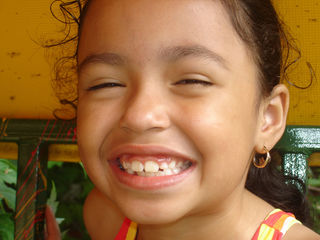Humor
The Best (Free) Thing You Can Pass Along to Your Kids
Teach children to laugh and you give them a tool that lasts a lifetime.
Posted January 8, 2019

The first time your baby smiles at you is one of parenthood’s most thrilling moments.
The first real social smile happens at around three months old. What may not have occurred to you in a conscious way is that beginning then—or even sooner—you can help your child develop a hearty sense of humor. And that can make nearly everything about their life better in the long run.
WITH INFANTS
In your baby's first months, try short bouts of tickling. Always be sensitive to facial or bodily expressions of displeasure. Smile a lot yourself, and freely use motherese, that higher-pitched musical way parents tend to talk to babies.
* In the second half of the first year, babies find amusement in being mimicked. Imitate your tot by chasing after her on your hands and knees, or pretend to suck on her baby bottle. In fact, anything unexpected may bring a laugh, such as putting a diaper on your baby’s head, or sticking a bottle nipple in her ear.
* Peek-a-boo games depend on predictable twists for their humor. When Linda Smith changed Sharra’s diaper, she would cover her eyes with her daughter’s feet, then pull the baby’s legs apart so she could see her mother’s face. When Sharra was about a year old, the Smiths traveled across the country. "My mother had made her a mermaid puppet with stringy hair,” said Linda. “We used the puppet to play peek-a-boo over the edge of the car seat, with the puppet flinging her hair. Sharra found it so amusing that it got us all the way through Wyoming and Montana.”
WITH TODDLERS
Once your baby can walk and talk, encourage her developing sense of humor by showing her offbeat, unexpected ways to look at reality. Jokes need to be direct and concrete, since your child is still too young to get a sophisticated punch line.
* Toddlers love physical absurdity and slapstick comedy. Wear her bunny slippers on your own feet, or put them on your fingers and have them talk to each other like puppets. Linda Smith tried putting one of Sharra’s hats on her dolls or on herself, and even put the hat on the rocking horse, on a ball, or on a Santa Claus. “She found that really silly," said Smith. "We once put a ball in a t-shirt, giving her a ‘ball with handles.’ She loved it."
* Consider the joyful possibilities of nicknames. Patti Wahlberg, a poet and writer in Vermont, shared the following list of some of the nicknames she gave her two now-grown girls: Boomer, Mung Bean, Hungry-osity, Sleepy-osity, Beany-copter, Skeetle-Deedle, Dylie Deedle, Frog Bottom, Noodly, Doodly, Princess Bomblebee, Beast-o-matic, Doogan, Happy-head, Girl-feathers, Girl-pie, Bobalooie, Moon Pie, Goober, Pupper-nutter, Boobalinski, Little Peeps.
WITH PRESCHOOLERS
Around the age of 3 and 4, when kids get the idea that certain things go with other things, their funny bone is easily stimulated with absurd words and images.
* One psychologist's son, when he was about four, thought it was really hysterical to name everybody in the family as a food. Dad was Daddy Soup, Mom was Mommy Carrot, and their retriever Goldie became Goldie Grapes.
* Use word play to surprise your child with the opposite of what she’s expecting: While handing her a dish, say, “Here, would you please put this elephant on the table for me?”
* One three-year-old liked to play “What color is that?” When she asked, “What color is the sky?” her mother guessed, “Purple.” The little girl would then laugh and say, “No!” and her mom would guess another color.
* When Patti Wahlberg's daughter was a preschooler, she asked her mother what she was making for lunch, and Patti would say something like, “We’re all having tuna sandwiches, but I'm making you your favorite — bug’s feet soup!!” “Kylie will laugh and laugh,” said Patti, “and then she told me I should have live ants for my lunch because I love them so much.”
* Open your child’s mind to creatively silly possibilities, such as, “Don’t you ever wonder what Poochie is thinking? He looks like he’s trying to invent a new kind of dog dish, doesn’t he?”
Copyright (c) 2018 by Susan K. Perry, author of Playing Smart and Kylie's Heel


